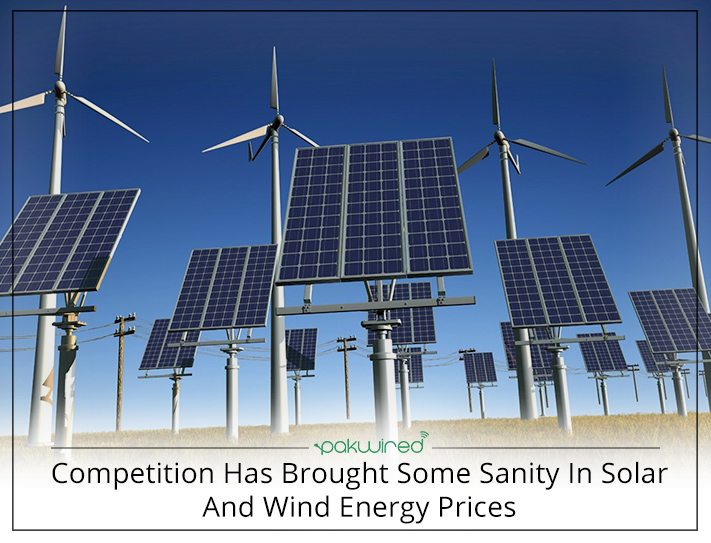Clean energy industry has seen dynamic changes during the last few years in terms of pricing, while its popularity has also gained momentum. There have been myriad of projects of solar and wind energy, and prices have seen a significant dip falling as low as 3 cents per kilowatt-hour (kWh) for projects in the UAE. The average price in other parts of the world hovers around 5 cents per kWh.
In case of Pakistan, the prices are generally higher compared to other parts of the world. However, prices have been reduced due to rising competition which is a welcoming sign, since the market rule suggests that rising competition takes a dip on the price trend.
At the outset, we will shed some light on continuous price reduction in solar and wind energy in contrast to higher energy prices that have always existed in the past. Later, we will talk about reasons for higher energy prices in Pakistan.
Read More: Solar Bibi Project – A ray of hope to curtail energy crisis in rural areas
International Price Structure
Looking at India’s example, solar energy prices during February 2017 have shrunk to 5.30 US cents per kWh while wind prices have followed suit standing at 5 US cents.
Competition for supply of various project capacities (from 100 megawatts to 750 megawatts) in solar photovoltaic (PV) has been severe. Auction prices have also reduced from 6.6 cents for 450 MW project in September 2016 to 5.3 cents in February 2017, for a higher capacity of 750 MW in one of its regions.
During February 2017, Wind power auction took place in India for an installation of 1000 MW capacity. The price fell from the regulated minimum tariff of 6 cents to 5 cents. This indicates the power of competition which has reduced prices drastically. Other countries such as Brazil, Mexico, South Africa and other countries have also seen similar price trends.
Comparing prices, the lowest end exists in UAE where solar PV auction rates oscillate around 3 cents. In US, long term agreements have been sealed at 2-2.5 cents. However, a subsidy termed as production tax credit has been announced which ranges between 1.50-2.3 cents thus taking the total price for wind energy to 3.5-4.8 cents in US.
Also Read: ADB provides $325 million to loan to KPK and Punjab to cope energy crisis
Pakistan: Prices have reduced but are still higher
There has been an announcement of tariff reduction by NEPRA in January 2017 where determination of wind power tariff stood at Rs6.7467 per kWh (6.41 cents) for foreign-funded projects and Rs7.732 (7.34 cents) for locally funded projects.
NEPRA provided the following reference rates:
Rs8.6066 for 100% local debt
Rs8.1968 for 100% foreign debt
The reason for higher local tariff is due to higher interest rates being offered in Pakistan versus global rates despite adding depreciation.
Solar PV electricity prices have hit a low figure of 6 cents versus 5.19 in India. This number is significantly lower due to currency differences between the two countries. The rates have been unimaginably higher initially for wind power at 14-17, more than 70 percent higher compared to other markets.
Solar PV prices started off at 17 cents in Pakistan during 2014 which then reduced to 11.35 cents in December 2015. Similarly, wind energy prices stood at 15 cents in 2012 while prices in other countries ranged between 7-8 cents.
In case of wind energy, the industry practice suggests that higher production capacity reduces prices. If we observe the capacity in India, it is much lower than Pakistan. However, the general price trend is on the downside which is a significant improvement compared to prices in early 2000’s.
Quick Read: Pakistan becomes first country to utilize high-quality solar maps – observes World Bank
Why prices are higher in Pakistan?
The authorities have been representing vendor interests for many years and holding public hearings as they lacked third party experts. NEPRA has finally realized this matter and initiated competitive pricing.
The general thumb rule suggests that higher prices contract the market and reduce its attractiveness for the users while lower prices increase demand thus leading to market expansion. Therefore due to higher prices, Pakistan has been losing out on its exports.
Competition however has its flip side as well if not managed effectively. There are chances of collusion and higher supply side risk which can make the entire process ineffective.
The slump in solar and wind energy prices has not been a surprise for the industry experts as they believed it was inevitable in the light of rising global competition. Additionally, many still propagate that the installation of power plants at high tariff of 17.85 cents has been needless.
Source: ET


